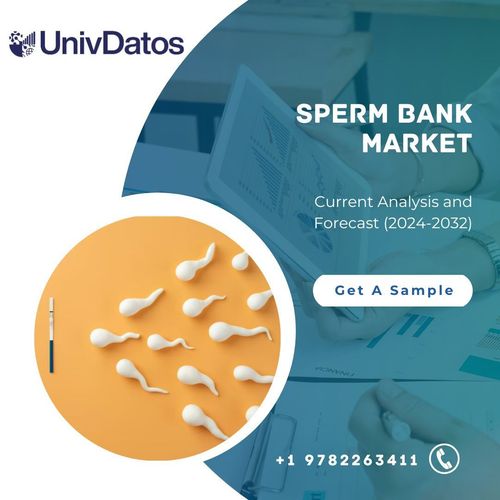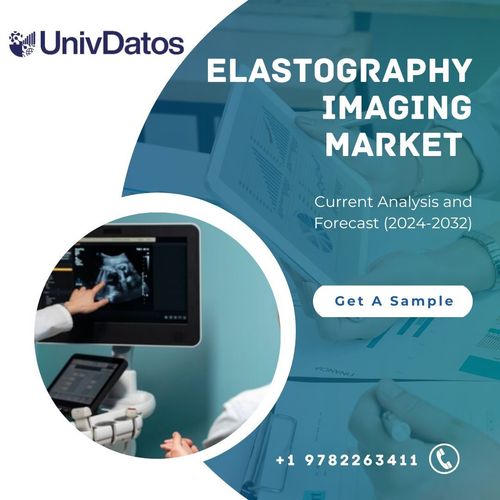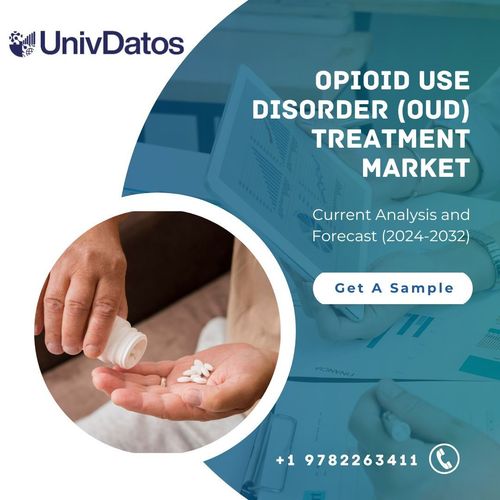Cell Culture Media Market: Current Analysis and Forecast (2021-2027)
Emphasis on Type (Lysogeny Broth, Chemically Defined Media, Classical Media, Serum-Free Media, Specialty Media, Stem Cell Media, Others); Application (Cancer Research, Biopharmaceuticals, Regenerative Medicine & Tissue Engineering, Diagnostics); End-Users (Pharmaceutical & Biotechnology Companies, Hospitals & Diagnostic Laboratories, Research & Academic Institutes, Others); Region/Country
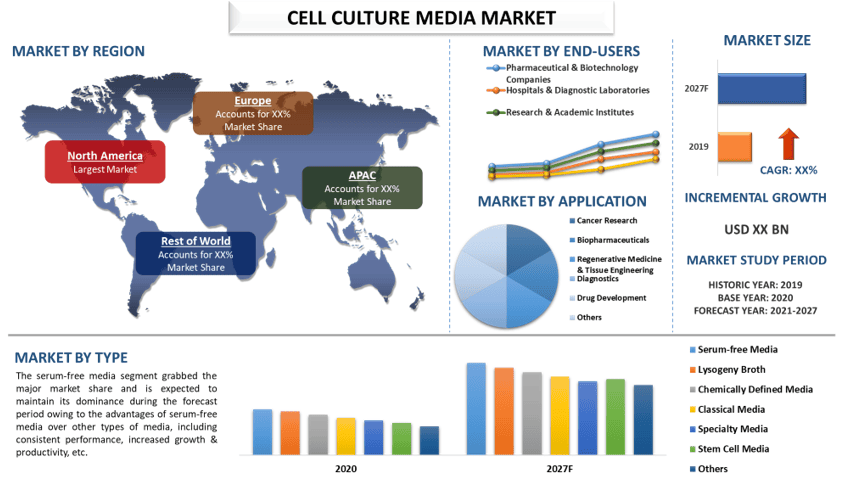
Global Cell Culture Media Market is anticipated to grow with an elevated CAGR of around 12% over the forecast period (2021-2027). Cell culture media usually consist of an appropriate source of energy and compounds which regulate the cell cycle. It contains different nutrients that help in the growth, proliferation, maintenance, and storage of microbial and other cell types including stem cells. A wide range of cell culture media is available in the market that facilitates the growth of different types of cells.
With rapid technological advancement in cell biology and rising investment in research & development of pharmaceutical & biotechnology companies, the cell culture media market is witnessing an uptick all over the globe. For instance, the Pharmaceutical Research and Manufacturers of America (PhRMA) trade group represents the leading biopharmaceutical research companies in the United States. In 2019, the research and development (R&D) expenditure of its member companies reached USD 83 billion worldwide, up from USD 79.6 billion in 2018. Furthermore, the growing focus on cell culture technology for developing monoclonal antibodies and support by the government for research and funding is propelling the growth of this market.
Furthermore, the cell culture media market is anticipated to grow on account of the rapid progress in biopharmaceuticals, oncology, and stem cell research. Cell culture plays a vital role in vaccine production and cell culture technology has been used to produce vaccines for chicken pox, polio, smallpox, hepatitis, etc. Also, cell culture-based vaccine production is far more efficient and offers many advantages over traditional manufacturing methods such as shortened lead-time and the capability to produce vaccines in larger quantities. Thus, recent years have witnessed an increased demand for cell-based vaccines, resulting in efforts by major industry players to capitalize on the opportunities provided. Thereby, boosting the growth of the cell culture media market globally. For example, in Feb 2020, Seqirus received US FDA approval for AUDENZ, a cell-based Influenza A (H5N1) Monovalent Vaccine for individuals aged six months and older.
Current & Projected Total Global Spending on Pharmaceutical R&D, 2016-2026 (in USD billion)
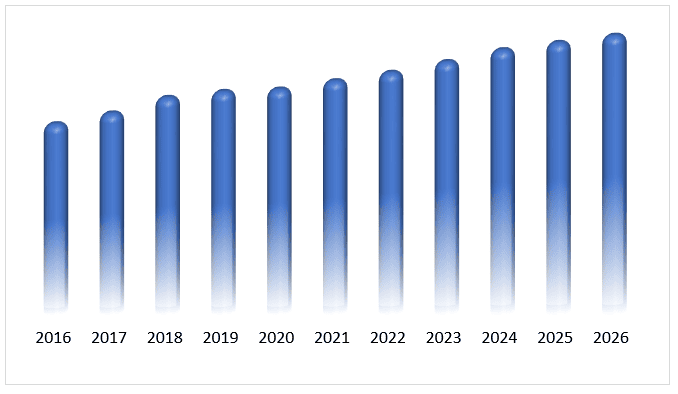
Thermo Fisher Scientific, Inc., Becton, Dickinson and Company, Bio-Rad Laboratories, Inc., Hi-Media Laboratories Pvt. Ltd., Merck KGaA, Corning Incorporated, Sartorius AG, Fujifilm Holdings Corporation, Lonza Group Ltd, Caisson Laboratories Inc., are some of the prominent players operating in the cell culture media market. Several M&As along with partnerships have been undertaken by these players to facilitate customers with cell culture media.
Insights Presented in the Report
“Amongst Type, serum-free media segment holds the major share”
Based on type, the cell culture media market is segmented into lysogeny broth, chemically defined media, classical media, serum-free media, specialty media, stem cell media, and others. The serum-free media segment accounted for a significant market share in 2020 and it is estimated that it will grow rapidly during the projected timeframe. The growth of this segment can be attributed to the advantages of serum-free media over other types of media, including consistent performance, increased growth & productivity, better control over physiological responsiveness, and reduced risk of contamination by serum-borne adventitious agents in cell culture.
“Amongst Application, biopharmaceuticals segment holds the major share”
Based on application, the cell culture media market is segmented into cancer research, biopharmaceuticals, regenerative medicine & tissue engineering, and diagnostics. The biopharmaceuticals segment occupied the major share of the cell culture media market in 2020 and it is expected to grow with a substantial CAGR in the upcoming years. The growth of this segment is attributed to the commercial expansion of major pharmaceutical and biotechnology companies and the growing demand for various biopharma products such as mAbs. Furthermore, the growing regulatory approvals to produce cell culture-based vaccines is also one of the prominent factors contributing to the growth of this segment.
“Amongst End-Users, pharmaceutical & biotechnology companies segment holds the major share”
Based on end-users, the market is fragmented into pharmaceutical & biotechnology companies, hospitals & diagnostic laboratories, research & academic institutes, and others. In 2020, the pharmaceutical & biotechnology companies segment grabbed a considerable market share, and it is expected to grow at a significant CAGR during the forecast period owing to the rising prevalence of various infectious diseases and increasing research and development activities by biotechnology and pharmaceutical companies. For example, In 2019, Cidara Therapeutics Inc., a biotechnology company focused on developing novel anti-infective CB-012, its Cloudbreak antiviral Fc-conjugate (AVC) candidate for influenza. Thus, these clinical trials are expected to increase the procurement of culture media for performing clinical tests of various drug molecules.
“North America represents one of the largest markets of cell culture media market”
For a better understanding of the market dynamics of the cell culture media market, a detailed analysis was conducted for different regions across the globe including North America (the U.S, Canada, and the Rest of North America), Europe (Germany, France, Spain, United Kingdom, Italy, and Rest of Europe), Asia-Pacific (China, India, Australia, Japan, and Rest of APAC), Rest of World has been conducted. North America constitutes a major market for the cell culture media market industry and generated revenue of USD XX Million in 2020 owing to strong healthcare infrastructure and growing adoption of advanced cell culture technology in the region.
Reasons to buy this report:
- The study includes market sizing and forecasting analysis validated by authenticated key industry experts
- The report presents a quick review of overall industry performance at one glance
- The report covers an in-depth analysis of prominent industry peers with a primary focus on key business financials, product portfolio, expansion strategies, and recent developments
- Detailed examination of drivers, restraints, key trends, and opportunities prevailing in the industry
- The study comprehensively covers the market across different segments
- Deep dive regional level analysis of the industry
Customization Options:
The global cell culture media market can further be customized as per the requirement or any other market segment. Besides this, UMI understands that you may have your own business needs, hence feel free to connect with us to get a report that completely suits your requirements.
Table of Contents
Analyzing the historical market, estimation of the current market, and forecasting the future market of the global cell culture media market were the three major steps undertaken to create and analyze the adoption of cell culture media in major regions globally. Exhaustive secondary research was conducted to collect the historical market numbers and estimate the current market size. Secondly, to validate these insights, numerous findings and assumptions were taken into consideration. Moreover, exhaustive primary interviews were also conducted, with industry experts across the value chain of the global cell culture media market. Post assumption and validation of market numbers through primary interviews, we employed a top-down/bottom-up approach to forecasting the complete market size. Thereafter, market breakdown and data triangulation methods were adopted to estimate and analyze the market size of segments and sub-segments the industry pertains to. Detailed methodology is explained below:
Seek More Details About Research Methodology
Seek More Details About Research Methodology
Analysis of Historical Market Size
Step 1: In-Depth Study of Secondary Sources:
Detail secondary study was conducted to obtain the historical market size of the cell culture media through company internal sources such as annual report & financial statements, performance presentations, press releases, etc., and external sources including journals, news & articles, government publications, competitor publications, sector reports, third-party database, and other credible publications.
Step 2: Market Segmentation:
After obtaining the historical market size of the cell culture media market, we conducted a detailed secondary analysis to gather historical market insights and share for different segments & sub-segments for major regions. Major segments included in the report as type, applications, and end-users. Further country-level analyses were conducted to evaluate the overall adoption of cell culture media across the globe.
Step 3: Factor Analysis:
After acquiring the historical market size of different segments and sub-segments, we conducted a detailed factor analysis to estimate the current market size of the cell culture media. Further, we conducted factor analysis using dependent and independent variables such as rising R&D spending in pharmaceutical companies and emerging cell culture technologies for cell-based vaccines. A thorough analysis was conducted for demand and supply-side scenarios considering top partnerships, mergers and acquisitions, business expansion, and product launches in the cell culture media sector across the globe.
Current Market Size Estimate & Forecast
Current Market Sizing: Based on actionable insights from the above 3 steps, we arrived at the current market size, key players in the cell culture media market, and market shares of the segments. All the required percentage shares split, and market breakdowns were determined using the above-mentioned secondary approach and were verified through primary interviews.
Estimation & Forecasting: For market estimation and forecast, weights were assigned to different factors including drivers & trends, restraints, and opportunities available for the stakeholders. After analyzing these factors, relevant forecasting techniques i.e., top-down/bottom-up approach was applied to arrive at the market forecast about 2027 for different segments and subsegments across the major markets globally. The research methodology adopted to estimate the market size encompasses:
- The industry’s market size, in terms of value (US$) and the adoption rate of cell culture media across the major markets domestically
- All percentage shares, splits, and breakdowns of market segments and sub-segments
- Key players in the cell culture media market in terms of products offered. Also, the growth strategies adopted by these players to compete in the fast-growing market
Market Size and Share Validation
Primary Research: In-depth interviews were conducted with the Key Opinion Leaders (KOLs) including Top Level Executives (CXO/VPs, Sales Head, Marketing Head, Operational Head, and Regional Head, Country Head, etc.) across major regions. Primary research findings were then summarized, and statistical analysis was performed to prove the stated hypothesis. Inputs from primary research were consolidated with secondary findings, hence turning information into actionable insights.
Split of Primary Participants in Different Regions
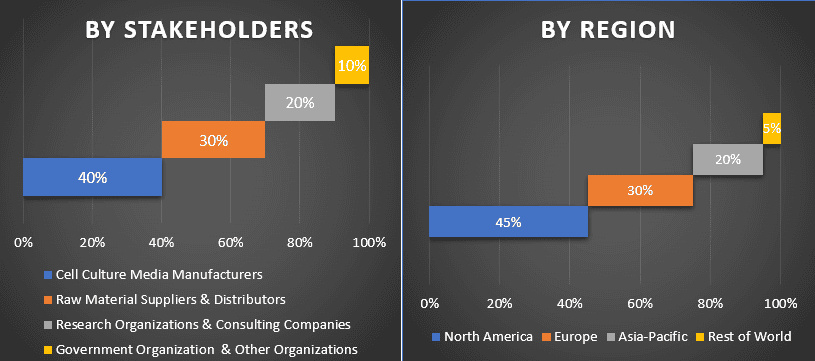
Market Engineering
Data triangulation technique was employed to complete the overall market estimation and to arrive at precise statistical numbers of each segment and sub-segment of the cell culture media market. Data was split into several segments & sub-segments post studying various parameters and trends in the areas of type, application, and end-users of the cell culture media market.
The main objective of the Cell culture media Market Study
The current & future market trends of cell culture media were pinpointed in the study. Investors can gain strategic insights to base their discretion for investments from the qualitative and quantitative analysis performed in the study. Current and future market trends were determined the overall attractiveness of the market at a regional level, providing a platform for the industrial participant to exploit the untapped market to benefit as a first-mover advantage. Other quantitative goals of the studies include:
- Analyze the current and forecast market size of cell culture media in terms of value (US$). Also, analyze the current and forecast market size of different segments and sub-segments
- Segments in the study include areas of type, application, and end-users
- Define and analysis of the regulatory framework for the cell culture media industry
- Analyze the value chain involved with the presence of various intermediaries, along with analyzing customer and competitor behaviors of the industry
- Analyze the current and forecast market size of the cell culture media market for the major region
- Major regions studied in the report include North America, Europe, Asia-Pacific and Rest of the world
- Company profiles of the cell culture media market and the growth strategies adopted by the market players to sustain in the fast-growing market
- Deep dive regional level analysis of the industry
Related Reports
Customers who bought this item also bought

